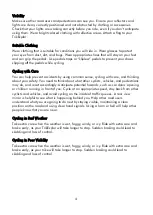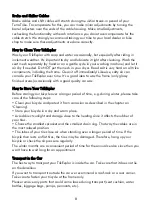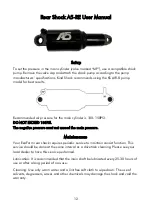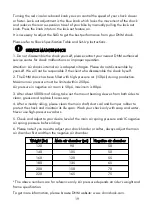
Suitable Clothing
Wear clothing that is suitable for conditions you will ride in. Wear glasses to protect
your eyes from dust, dirt, and bugs. Wear appropriate shoes that will stay on your feet
and can grip the pedals. Use pedal straps or “clipless” pedals to prevent your shoes
slipping off the pedals while cycling.
Cycling with Care
You can help prevent accidents by using common sense, cycling with care, and thinking
about your safety. You need to think about what other cyclists, vehicles, and pedestrians
may do, and react accordingly. Anticipate potential hazards, such as car doors opening
or children running in front of you. Cycle at an appropriate speed, stay back from other
cyclists and vehicles, and avoid cycling on the inside of traffic queues. A rear view
mirror is helpful to see what is happening behind you. Help other road users
understand what you are going to do next by staying visible, maintaining a clear
position on the road and using clear hand signals. Using a horn or bell will help other
people know that you are near.
Cycling in Bad Weather
Make sure other road users and pedestrians can see you. Ensure your reflectors and
lights are clean, correctly positioned and not obstructed by clothing or accessories.
Check that your lights are working correctly before you ride, even if you don’t anticipate
using them. Wear bright colored clothing with reflective areas. Attach a flag to your
TrikExplor.
Visibility
Take extra care when the weather is wet, foggy, windy, or icy. Ride with extra care and
brake early, as your TrikExplor will take longer to stop. Sudden braking could lead to
skidding and loss of control.
Cycling in Poor Visibility
Take extra care when the weather is wet, foggy, windy, or icy. Ride with extra care and
brake early, as your trike will take longer to stop. Sudden braking could lead to
skidding and loss of control.
4





































